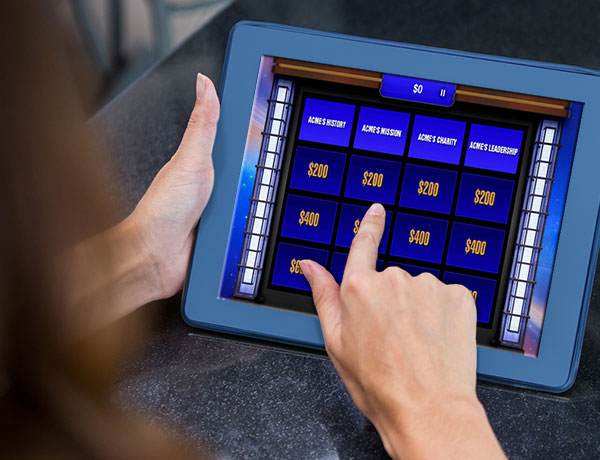It’s happening again. Your students are dozing off, not paying attention, or posting on social media while you give that lecture you’ve worked so hard on.
Why aren’t they invested in this material? Truth is, students – and most everyone – crave interaction and agency. Students want to be involved in their learning and education, not just sit there and be passive.
People have more fun when they’re interacting with each other as opposed to listening to you, no offense, of course. So, how do we go about creating this agency and interaction?
Proven to be effective for all ages and across all disciplines, gamified learning fulfills this desire for teamwork and interaction.
How Games Provide Microlearning, Feedback, and Fosters Team-Building Skills
As GenZ (representing those born between the mid-1990s through 2012) becomes more prevalent in our universities and workforce, it’s imperative that colleges start to better understand this unique group of individuals. GenZ is comprised of true digital natives and will have no issues adopting a new form of gamified education technology.
In addition to their love of technology, GenZ is also known for its short attention span; about eight seconds if you can believe it. Because of this, they respond really well to the concept of microlearning; breaking down learning topics into more manageable pieces and repeating them with adequate spacing between lessons. Using gamified learning is perfect for this style of digestion as games can be 3-4 minutes long with “bite-sized” content.
Think about it, as sad as it is to say, if a friend sends you a video to watch and it’s over two minutes long, do you really watch it? Who’s got the time, right?
Now think about an hour-long lecture where you’re a disinterested student. An hour is closer to an eternity! Breaking up that time with quick, interactive games can help increase engagement and get that one snoozing student in the back to pay attention.
Feedback and Gamified Learning
GenZ – along with their slightly older millennial counterparts – crave constant feedback. According to one survey, 74% of millennials feel “in the dark” about their job performance due to a lack of feedback. Having only a yearly or quarterly review isn’t enough for these generations that want the feedback cycle to be constant.
What can provide a more casual, interactive, and more frequent feedback structure? A gamified learning structure. Gamified learning can help both you and your students increase communication and make sure the experience is meaningful and constructive.
So, instead of students submitting work, grading it, sending it back to the student, and having that process take days or weeks, games make feedback instant.
If a student selects the incorrect answer in a gamified setting, the response is immediate. The game can provide constructive feedback and gives the student a chance to try again. Using gamified learning gives students a safe space to fail, adjust, and try again in seconds or minutes.
Understanding this desire for feedback can go a long way in getting students to engage in your lesson plan. Take steps to gamify your classroom and you’ll be on your way to improving engagement through immediate feedback
Teamwork and Problem Solving
Teamwork is superior to group work in that a “group” is a set of individuals that work independently towards a common goal. A team encourages collaboration as students will have to work together towards a common goal.
If the students are in a team and playing a game, there will be clearly defined challenges, rules, and rewards. By working together on the team to meet those challenges and in the game, the team and students will have used and improved their teamwork and problem-solving skills.
While the team is playing the game they can receive instant feedback, adjust their strategy, learn, engage, and solve the problem. At the same time, the game can also offer a reward or simply the top spot on the leaderboard to brag about to other students.
Whether these games are remote or in-person they can bring a sense of belonging to your team; be they, students or colleagues. An MBA program used interactive, outdoor games to teach soft skills, teamwork, and problem-solving to its students. After the games, the greatest increase in student knowledge was in communication and leadership; arguably important skills to have when building effective teams.
This increase in teamwork skills came from interactive, team-oriented games, and not through a passive lecture or reading assignment.
Gamified Learning Increases Knowledge Retention
In a study of 1,000 games, it was found that the average time spent per session was six minutes; definitely filling the microlearning checkbox. The learners, however, repeated the games on average 2.9 times. They wanted to go back and play the learning game again which we know helps reinforce learning. Most importantly, there was a 64% lift in knowledge from the 1st to the 3rd time students answered questions after learning with games.
Using gamified learning provides a safe space for learners to re-engage with content. As we all know, repeat engagement with the material is the best way to beat the “forgetting curve” we all suffer.
Being active in one’s learning greatly increases engagement and therefore retention. Instead of a lecture or PowerPoint, discussion, practice, and teaching itself are the best ways to achieve active learning. In a team-based game, you can satisfy two if not all three of those points to drive retention of the learning material.
Another way games increase retention is by invoking an emotional response. In a study of training methods for aviation safety professionals, one set was trained using traditional “safety card” methods while the other used virtual reality (VR) training simulation much like the CenarioVR training tool.
When finished, the study found that those who used the VR training had higher knowledge retention than those using traditional methods. Being immersed in a virtual, gamified learning environment invoked a strong emotional response. This response made the students retain and recall the information better than those using traditional learning methods.
Gamify Online Learning
When everyone was thrown online because of the pandemic, many professors realized that traditional teaching methods were not effective. It’s hard enough to keep students engaged in a lecture in person, it can be near impossible when they’re online with numerous distractions in arms reach.
Looking to tackle this problem, MIT’s Sloan School of Management underwent extensive research to show just how effective gamified education techniques can be at combating the engagement issues that come with online education.
The head of the study, Professor Lo took some lessons from video game streamers to boost engagement. He used a countdown to announce class starting, a variety of tools on Zoom like polls, chat, and breakout rooms and switched up tasks and screens every fifteen minutes to make sure students stayed engaged. This “change in scenery” also helps with the Zoom fatigue we all struggle with.
Leveraging True Gamification in Higher Ed Teaching
Using games in your classroom is not the same as gamifying your classroom. First, gamification is the application of gameplay elements (points, competition, rewards, etc.) to real-world situations. So while fun, playing bingo in your class is not the same as true gamified learning.
Incorporating game mechanics go a long way to increasing engagement and gamifying education. Using things like game levels gives a sense of accomplishment, points give something to earn and possibly used as currency, and a leaderboard encourages healthy competition.
Maybe the best game mechanic, however, are badges or achievements. Typically in classrooms, motivation centers around securing a good grade or fear of receiving a bad one. Of course, grades are important and necessary, but they might not be the best motivating factor for many students.
Instead of only using grades, try adapting a badge or awards system, to help encourage and reward behaviors. Something as simple as the “perfect attendance badge” or “answered a question in every class badge” can further drive engagement and ownership in a student’s educational journey and give students achievements in things that aren’t just grades and assignments.
On top of that, students can share these achievements with the class and continue the trend of encouraging interaction. Plus, seeing their fellow students rack up points, rewards, and badges might motivate them to get a move on that homework assignment and get on the leaderboard!
Gamification in the College Admissions and Orientation Process
Another aspect of gamification that universities are realizing is gamifying the admissions process. Applying to schools is arduous, can feel defeating, and is stressful. Once accepted, it’s time for students to celebrate and be excited about their new home.
Nazareth College in Rochester, NY, is using a points-based system for accepted students that help them earn gear, prizes, and other goodies for completing steps in the admissions process. Usually, filling out paperwork – or paying a deposit – isn’t the ideal of fun. However, if students earned points or unlocked new paths or “quests” in their pursuit of a degree, that can turn a bureaucratic process into an adventure.
Using a gamified admissions system can help colleges and universities better engage GenZ and millennial students. By employing gamified techniques to the application and selection process, it can become more fun and engaging.
Though most people talk about a gamified classroom, gamification isn’t just for students. Gamified learning increases engagement in all age groups which can include faculty and staff.
Among other things, using games from an organizational standpoint can help provide key data points, improve engagement amongst your staff, and overall create a positive work culture.
Next time there’s a training session or workshop for faculty and staff, spice it up after it’s finished with a round of JEOPARDY!® to help reinforce the concepts you just presented. JEOPARDY! is a familiar game mechanic and it helps with that magic word, engagement.
Gamify Higher Education in the Classroom and Administration Offices
To gamify your classroom is to empower your classroom. Gamified learning can increase learner engagement, recall, and retention, improve problem-solving and critical thinking skills, and fulfill a desire to work in teams. Plus, your students and learners have fun! Imagine that, your students will be more engaged if they’re enjoying themselves.
Using gamified learning makes you a hero. In higher education, that hero can be a classroom professor, an administrator, or a staff member.
Harness the benefits of gamification and instead of students posting on social media out of boredom, maybe they can post that achievement they earned in your gamified classroom.



